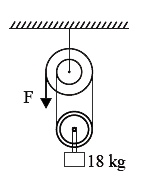Figure (i) shows a spring of force constant k clamped rigidly at one end and a mass m attached to its free end. A force F applied at the free end stretches the spring. Figure(ii) shows spring with both endsd free and attached to a mass m at either end. Each end of the spring in figure (ii) is stretched by the same force F.

(a) What is the maximum extension of the spring in the two cases ?
(b) If the mass in figure (i) and the two masses in Figure (ii) are released free. what is the period of oscillation in each case ?
The correct Answer is:(a) Maximum extersion =FK (for both cases)
(b) in fig. (a), m is the inertia factor and k is the spring factor.
T=2π√inertia factorspring factor or T=2π√mk
in Fig. (b), md2x1dt2=−kx and md2x2dt2=kx
Change in length of spring x=(x1−x2)
or d2xdt2=d2dt2(x1−x2) [Note that I is constant]
or md2xdt2+2kx=0
or d2xdt2+2kmx=0 or d2xdt2+ω2=0
or ω=√2km⇒T=2πω=2π√m2k
Alternate : Reduced mass of the given two-boy system.
μ=m×mm+m=m22m=m2
inertia factor =m2 and spring factor =k
∴ Time period , T=2π√m/2k=2π√m2k
Step by step video solution for Figure (i) shows a spring of force constant k clamped rigidly at one end and a mass m attached to its free end. A force F applied at the free end stretches the spring. Figure(ii) shows spring with both endsd free and attached to a mass m at either end. Each end of the spring in figure (ii) is stretched by the same force F. (a) What is the maximum extension of the spring in the two cases ? (b) If the mass in figure (i) and the two masses in Figure (ii) are released free. what is the period of oscillation in each case ? by Physics experts to help you in doubts & scoring excellent marks in Class 12 exams.
Topper's Solved these Questions
- BOOK - RESONANCE ENGLISHCHAPTER - SIMPLE HARMONIC MOTION EXERCISE - Exercise- 1, PART - I25videos
SIMPLE HARMONIC MOTION
- BOOK - RESONANCE ENGLISHCHAPTER - SIMPLE HARMONIC MOTION EXERCISE - Exercise- 1, PART - II36videos
SIMPLE HARMONIC MOTION
- BOOK - RESONANCE ENGLISHCHAPTER - SIMPLE HARMONIC MOTION EXERCISE - Solved Miscellaneous Problems9videos
SIMPLE HARMONIC MOTION
- BOOK - RESONANCE ENGLISHCHAPTER - SEMICONDUCTORSEXERCISE - Exercise 388videos
SEMICONDUCTORS
- BOOK - RESONANCE ENGLISHCHAPTER - TEST PAPERSEXERCISE - PHYSICS784videos
TEST PAPERS
Similar Questions
Figure a) shows a spring of force constant k clamped rigidly at once end and a mass m attached to its free end. A force F applied at the free end stretches the spring. Figure b) shows the same spring with both ends free and attached to a mass m at either end. Each end of the spring in figure is stretched by the same force F.
(a) What is the maximum extension of the spring in the two cases ?
(b) If the mass in figure and the two masses in figure are released free, what is the period of oscillation in each case?
 View Solution
View SolutionFigure a) shows a spring of force constant k clamped rigidly at once end and a mass m attached to its free end. A force F applied at the free end stretches the spring. Figure b) shows the same spring with both ends free and attached to a mass m at either end. Each end of the spring in figure is stretched by the same force F.
(a) What is the maximum extension of the spring in the two cases ?
(b) If the mass in figure and the two masses in figure are released free, what is the period of oscillation in each case?
 View Solution
View Solution
Knowledge Check
- Question 1 - Select One
A spring is stretched by applying a load to its free end. The strain produced in the spring is
AvolumetricBshearClongitudinal and shearDlongitudinal.

Figure. (a) shows a spring of force constant k fixed at one end and carrying a mass m at the other end placed on a horizontal frictionless surface. The spring is stretched by a force F. Figure. (b) shows the same spring with both endsf free and a mass m fixed at each free end Each of the spring is streched by the same force F. The mass in case (a) and the masses in case (b) are then released. Which of the following statements are true?View SolutionA spring with one end attached to a mass and the other to a right support is stretched and released
View SolutionAn ideal spring with spring constant k is hung from the ceiling and a block of mass M is attached to its lower end. The mass is released with the spring initially unstretched. Then the maximum extension in the spring is
View SolutionAn ideal spring with spring constant k is hung from the ceiling and a block of mass M is attached to its lower end. The mass is released with the spring initially unstretched. Then the maximum extension in the spring is
View SolutionA spring is stretched by applying a load to its free end. The strain produced in the spring is
View SolutionTwo springs have force constants kA such that kB=2kA. The four ends of the springs are stretched by the same force. If energy stored in spring A is E, then energy stored in spring B is
View SolutionIn the figure at the free end a force F is applied to keep the suspended mass of 18 kg at rest. The value of F is :
 View Solution
View Solution

